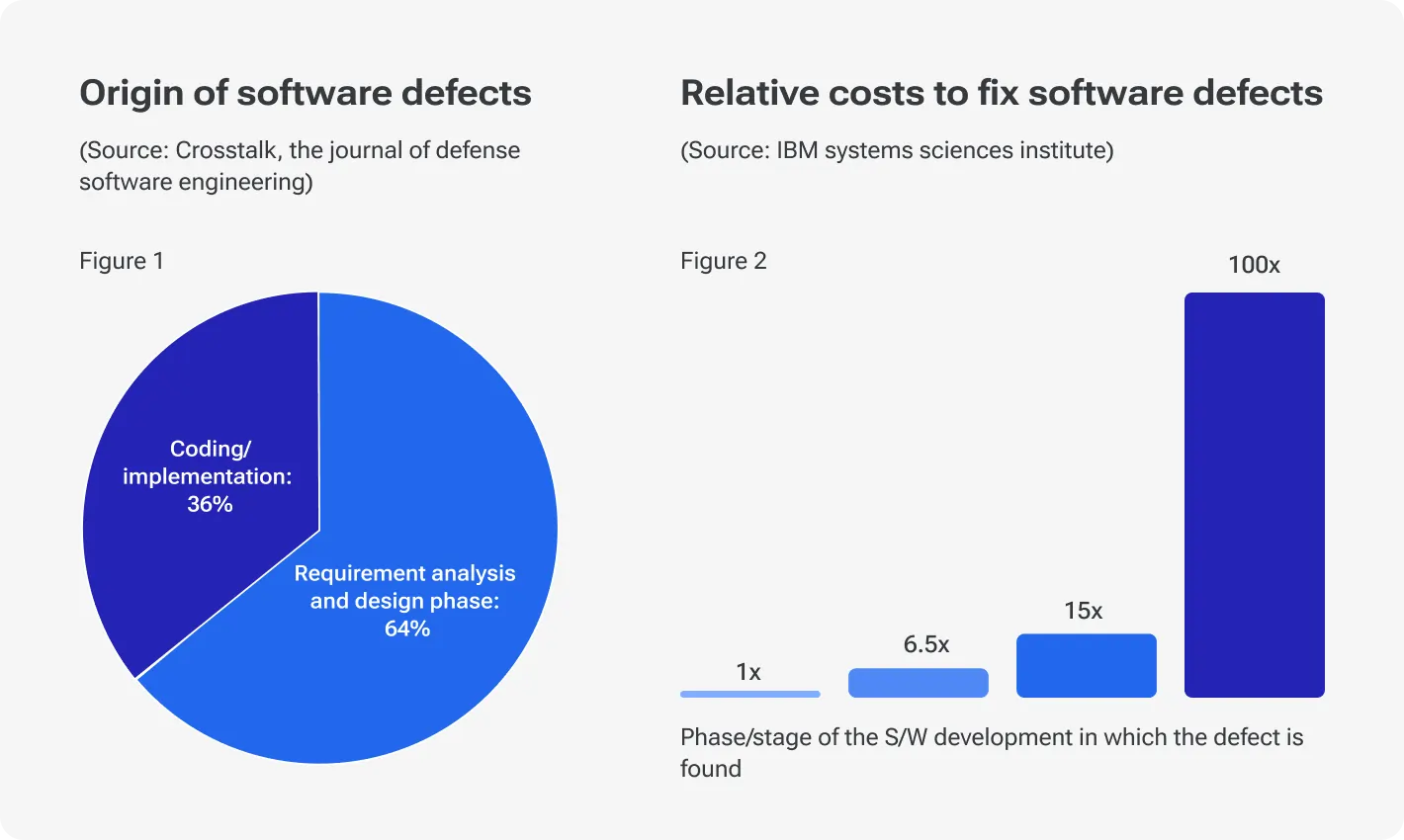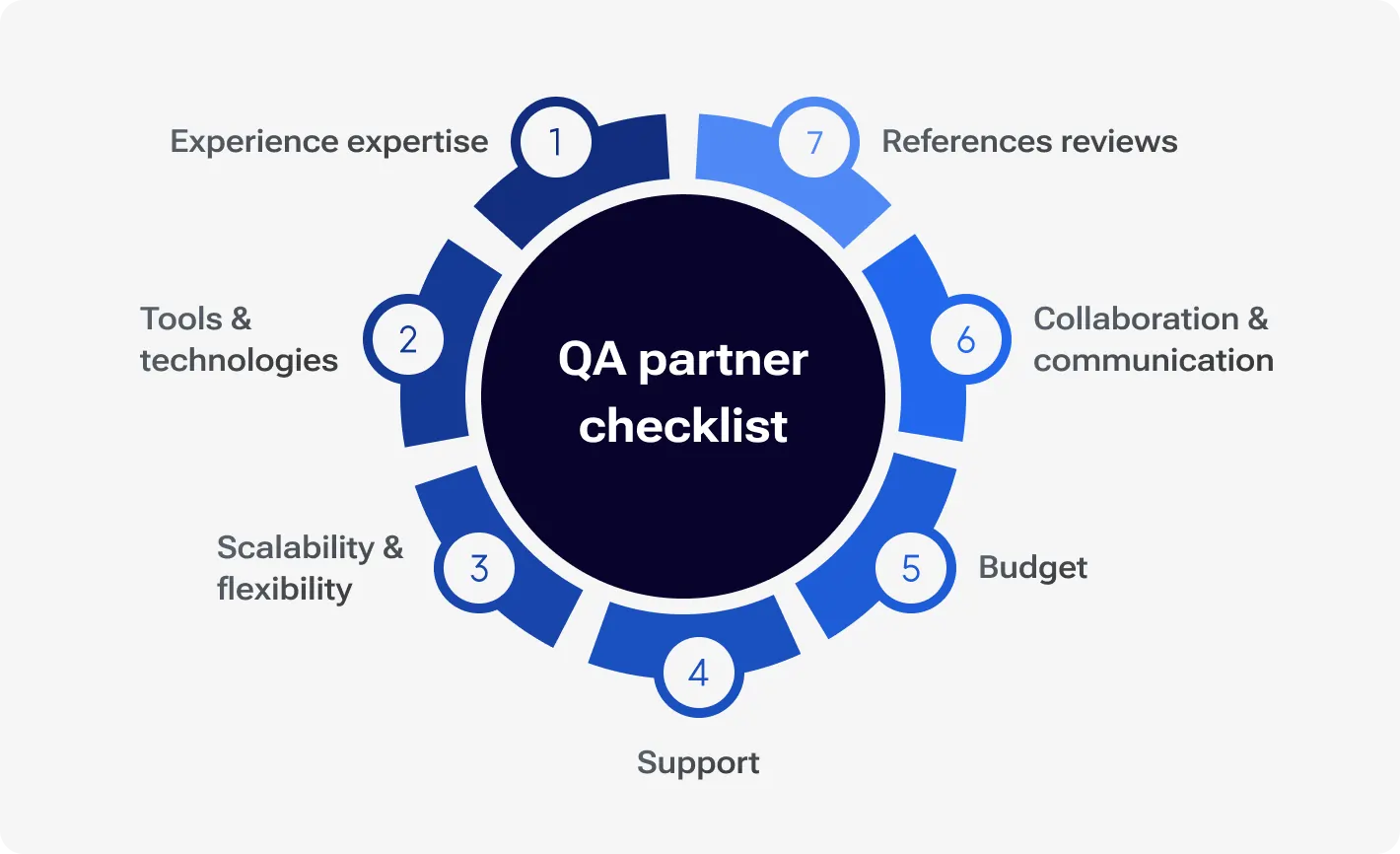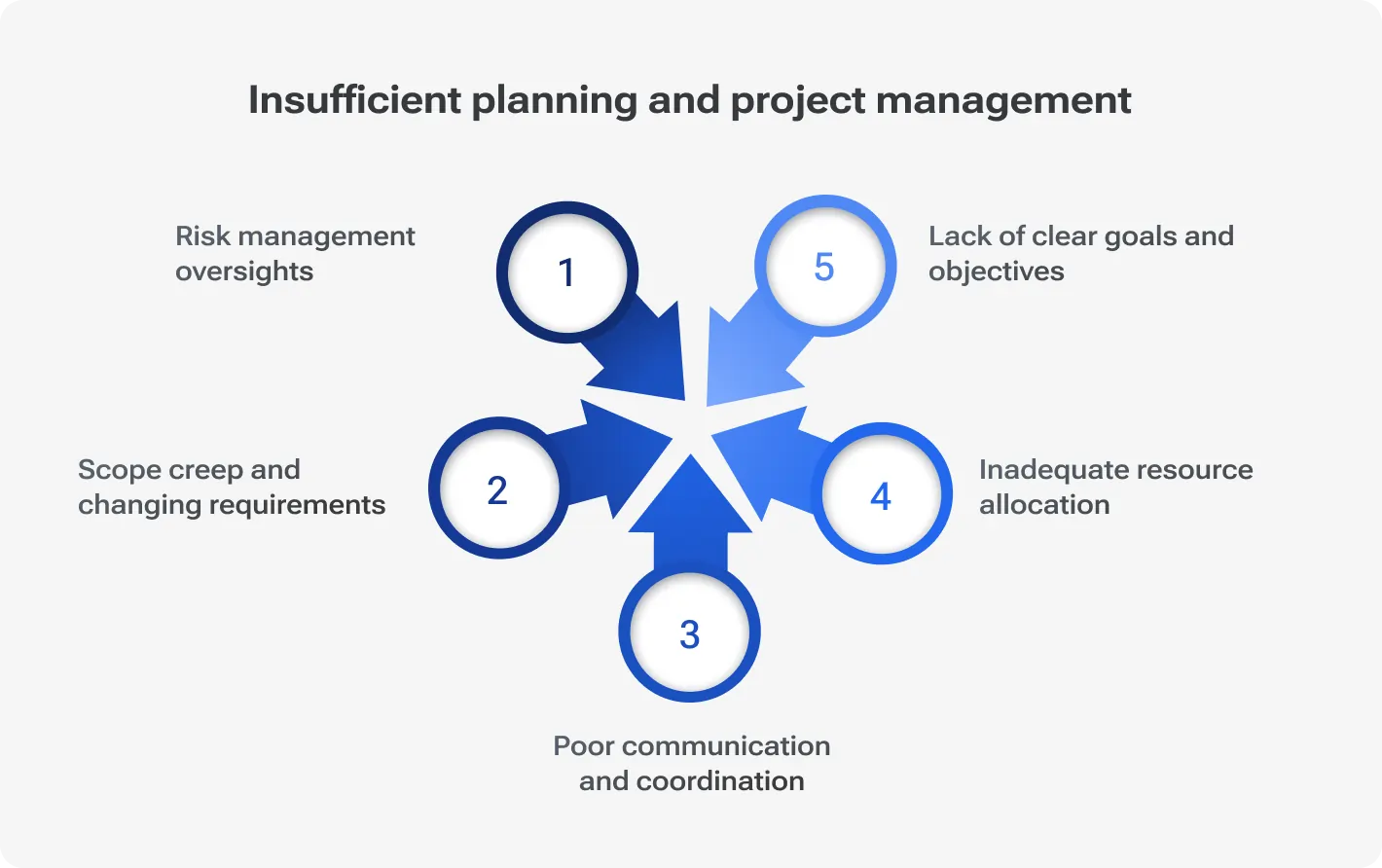Outsourcing software development is like hiring a construction crew to build your dream home. With experts who know their job well, you can save on costs, witness expert craftsmanship, and finish the project faster. However, building your dream home is only possible if everything is planned with utmost precision. With the wrong team, you can end up with a house that leaks, cracks, and never gets finished.
The same goes for custom software development outsourcing. While it offers some major advantages, there are outsourcing mistakes that can derail the entire process. Even small missteps can lead to project delays, budget blowouts, and unusable software. According to Statista, IT outsourcing revenue is projected to reach $541 billion by the end of 2025. However, the estimates by McKinsey also indicate that about 50% of all outsourced software projects fail to meet client expectations.
As Satya Nadella, CEO of Microsoft, said: “Every company is a software company. You have to start thinking and operating like a digital company.”
But thinking digitally requires smart decision-making. This article dives into seven critical outsourcing mistakes businesses make and shows how to dodge them. We use examples, actionable strategies, and custom software development outsourcing insights will help you with the best results.
End-to-end solutions with predictable budgets, a time-to-market advantage with budget savings of up to 50%
Outsourcing mistake #1. Unclear and inaccurate requirements kill software projects
Let’s return to the construction crew analogy. Imagine you hire the team to build your house, but don’t tell them how many rooms you want or what the overall layout should be. The crew will start laying bricks without the blueprint, and the result will definitely disappoint. The same is true for outsourced custom software development. The process won’t deliver good results when project requirements are unclear.
Why does this happen
According to Gartner, 37% of software projects fail primarily due to unclear or shifting requirements. This makes it the most cited cause of project failure. In turn, when a project has clear requirements before development starts, the chance of project success is about 97%.
In many cases, companies dive into custom software development outsourcing, having some rough idea in their head. Often, there is no formal documentation at this point. The problem stems from internal pressure to get started as soon as possible.
However, without a shared understanding of project goals, features, user needs, and constraints, developers may be forced to guess. In such a case, those guesses often miss the mark. Naturally, assumptions breed miscommunication. Miscommunication leads to rework. Rework equals delays, frustration, and wasted budget.
How to avoid it
-
Document everything. Start with business goals, user personas, functionality, compliance needs, and system constraints.
-
Create visual assets. Wireframes, mockups, and flow diagrams help align expectations.
-
Use agile feedback loops. Break the project into sprints, review progress regularly, and course-correct early.
Devico’s approach
As a trusted IT software outsourcing company, we at Devico don’t write a single line of code until the requirements are locked. Their discovery phase includes:
technical feasibility checks;
Our experts also use various tools to visualize and document everything, ensuring your idea is crystal clear before any development begins.
Outsourcing mistake #2. Choosing the wrong partner and starting on the wrong foot
Choosing the wrong outsourcing software development company is like hiring a plumber to install solar panels. The person you hired might be the best expert in the world. However, they will be unqualified for the job at hand.
According to the Deloitte Global Outsourcing Survey, 63% of companies identify vendor mismatch as the main reason their outsourcing efforts fail. In other words, choosing the wrong partner is not a rare misstep; it’s one of the most damaging.
Finding the right development partner is more than considering the cost and credentials. It is about alignment on many aspects, including:
Without such an alignment, even simple projects can spiral into chaos.
Why does this mistake happen
Companies often choose vendors based on the lowest bid or an overly polished pitch to cut costs or speed things up. However, once the kickoff meeting ends and actual work begins, issues such as mismatched skills, poor understanding of the domain, or lack of proactive communication start bubbling up.
A sleek website or a “yes-we-do-it-all” attitude makes it easy to be dazzled. But it won't take long before the cracks show if a vendor lacks relevant experience or can’t speak your language.
How to avoid it
-
Review relevant case studies. Focus on examples from your industry or use case.
-
Check references. Reach out to past clients and verify success stories.
-
Test communication early. Use a pilot project or technical assessment to evaluate collaboration.
-
Don’t rush the selection. A well-structured RFP and interview process helps filter out unfit providers.
Devico's approach
At Devico, we understand that good partnerships start with mutual understanding. That is why we provide case studies, offer technical discovery sessions, and allow trial engagements before long-term contracts. You see how we work, not just promises.
Learn how global healthcare giant relies on us to improve patient outcomes and lower systemic healthcare costs
Outsourcing mistake #3. The negative impact of a communication gap
According to the PMI Pulse of the Profession, 57% of failed projects cite poor communication as the leading cause. Communication is the oxygen of any outsourcing relationship.
The longer a miscommunication goes unchecked, the more expensive it becomes to fix. In turn, PMI’s different research indicates effective communication to be the project’s most crucial success factor, and 55% of project managers agree with such a number.
The lack of communication is one of the key outsourcing mistakes. Without communication, plans with the best design can suffocate. When teams don’t talk effectively, misunderstandings pile up, tasks duplicate, and trust evaporates.
Why does this mistake happen
Communication gaps in outsourced projects happen due to:
-
Time zone differences;
-
Language barriers;
-
Cultural misunderstandings.
It gets worse when there's no structure in place. When updates are buried in long email threads or there’s confusion over who to contact for what, the result is usually frustration and delay.
How to avoid it
Use project management tools like Jira, Asana, or ClickUp. Centralize updates, tasks, and milestones.
Adopt real-time communication tools like Slack or Microsoft Teams. Ensure day-to-day visibility and quick clarifications.
Schedule regular video meetings. Even short 15-minute check-ins will be of great benefit. Stay aligned and build rapport.
Use visual aids like screen shares, prototypes, or Loom videos to reinforce expectations.
Devico’s approach
For us, consistent communication with stakeholders is non-negotiable. Every project includes
english-fluent project managers;
time zone-overlap planning;
clearly defined communication ladders.
Your dedicated software development team always knows who to contact and when. This structured flow helps avoid bottlenecks, keeps projects moving, and fosters a transparent, collaborative working environment.
Outsourcing mistake #4. Lack of or insufficient project management
Software outsourcing companies do not always offer proper project management. The Standish Group’s CHAOS Report found that 47% of failed IT projects list poor project management as the primary reason for failure. Without strong coordination, even the most skilled teams fall short.
Outsourcing without proper project management is like setting sail without having a compass. While moving forward, you will have no idea where you are headed.
Why does this mistake happen
Many companies assume — once you sign a contract, the IT software outsourcing company will take full control over the entire project. However, while your vendor might be technically capable, they do not understand your business and projects inside out. Unless you guide them through your process, they won’t know your:
stakeholder expectations;
Without a clear structure and leadership, many things will start to drift. For example, tasks go unassigned, decisions are delayed, and scope creep takes over. As a result, the entire project will be bloated, late, and off the mark.
How to avoid it
Adopt Agile frameworks like Scrum or Kanban for better planning, collaboration, and feedback cycles.
Define clear milestones and KPIs before development begins to measure progress accurately.
Assign a project owner or internal liaison to coordinate decisions, approve changes, and serve as the bridge between your company and the vendor.
Use tracking tools like Trello, ClickUp, or Jira to visualize progress and address blockers early.
Devico’s approach
To affirm the right project management, we assign certified Agile Scrum Masters, dedicated R&D center, and experienced project managers to every client engagement. They handle sprint planning, lead daily stand-ups, and manage timelines through live dashboards. You have complete visibility and control.
Outsourcing mistake #5. The dangers of prioritizing price over quality
Having the sole focus on price is a major outsourcing mistake. According to a Clutch survey, projects handled by low-cost vendors are 30% more likely to face post-launch issues than those managed by mid-range or premium firms.
When you go with the cheapest vendor, it might feel like you’ve scored a great deal. In software development outsourcing, cutting costs can often mean cutting corners. The best software outsourcing companies provide the right balance between cost and quality.
Why does this mistake happen
It is only natural that every business and company wants to save money. With tight budgets, going for the lowest bid on the market is tempting. It can be extremely hard to make the right decision when all the proposals you went through offer the same results. Yet, in reality, price doesn’t always equal value.
The ugly truth is that low-cost providers often reduce their rates by hiring underqualified developers. They can also skip proper testing or rush delivery without having proper documentation. Such shortcuts may not show up immediately. Yet, with some time, they will come back to haunt you in the form of bugs, security breaches, and costly rebuilds.
How to avoid it
Evaluate long-term value, not just upfront cost. Look for technical expertise, previous results, and how well the provider understands your domain.
Ask for proof of quality. GitHub samples, code review practices, security protocols, client references, and relevant certifications.
Make security and scalability non-negotiable parts of your selection criteria.
Devico’s approach
We try our best to strike the right balance between affordability and top-tier quality. As one of the software outsourcing companies, we don’t compete on being the cheapest, and we compete on value delivered. Our engineers
follow ISO 9001 and 27001 standards;
implement secure development practices;
deliver scalable, clean code.
As a result, you can build on confidently, without worrying about fixing someone else’s shortcuts.
10 questions to ask your software development outsourcing vendor
Outsourcing mistake #6. Not protecting your assets can lead to legal and security risks
In custom software development outsourcing, failing to lock down intellectual property and data security can lead to some of the most damaging trust-related consequences imaginable.
According to the IBM Cost of a Data Breach Report, the average cost of a data breach reached $4.48 million in 2024, the highest it’s ever been.
Handing over your software idea without proper legal protections is like giving someone the keys to your house without knowing the person.
Why does this mistake happen
Often, company owners push aside legal agreements and security protocols putting speed on the pedestal. Besides, 70% of breached organizations report that breaches cause significant or very significant disruption. Businesses are eager to start and assume these things can be handled “later.” But when source code, proprietary algorithms, and user data are involved, you can’t afford to be casual.
Many companies also underestimate the complexity of cross-border legal protections. What’s standard in one country might not apply in another. Without tight contracts and reliable security practices, you’re not just at risk of project failure. As a result, you could face regulatory fines, IP theft, or loss of customer trust.
How to avoid it
Sign NDAs, IP transfer agreements, and clearly define data ownership and usage rights.
Use encrypted storage, VPNs, and access controls to limit exposure.
Ensure compliance with local and global regulations like GDPR, HIPAA, or PCI DSS.
Devico’s approach
As a trusted outsourcing software development company, we take legal and security protections seriously from day one. Our legal team drafts detailed contracts to cover IP rights, confidentiality, and non-compete clauses. We enforce strong security practices, including VPN-enforced access, data encryption, and regular security audits.
Outsourcing mistake #7. The need to be prepared for any changes out there
Custom software development outsourcing rarely follows a straight and fully predictable path. In some sense, it is like driving on a road full of unexpected turns. If your team isn’t ready to shift gears when the road changes, your entire project can go off course.
Why does this mistake happen
Many companies approach outsourcing software development with an established mindset — they assume the requirements defined at the beginning will hold firm through the entire project. But in reality, things change. New regulations pop up. Customer feedback demands new features. Technical constraints force design changes.
According to McKinsey, change requests affect many software projects, making them more common than most teams anticipate.
When teams lack a flexible process or the tools to manage change, small adjustments quickly snowball into confusion, delays, and client-vendor tension. Without built-in adaptability, these projects become fragile and break easily under pressure.
How to avoid it
Allocate buffer time and budget for handling scope changes, user feedback, and unknowns.
Adopt Agile practices such as Scrum or Kanban. Support flexibility by allowing scope re-prioritization every sprint.
Establish a change control process where every new request is evaluated, estimated, and approved. Ensure structured adaptability instead of chaos.
Devico’s approach
At Devico, flexibility is built into every project. Our Agile teams work in sprint cycles, hold retrospectives to reflect on what needs improvement, bring forward build-operate-transfer solution, and adjust scope without losing momentum. We ensure the roadmap can shift without derailing the entire journey to help you adapt fast while staying on track.
Conclusion
Outsourcing custom software development offers huge benefits—but only if you steer clear of common pitfalls. Let’s quickly recap the key mistakes and how to avoid them:
-
Unclear and inaccurate requirements. Start with thorough documentation, visual aids, and agile feedback loops to minimize miscommunication and rework.
-
Choosing the wrong partner. Focus on industry experience, communication quality, and cultural fit, not just cost or polished presentations.
-
Communication gaps. Set up structured communication processes with real-time updates, visual aids, and consistent stakeholder involvement.
-
Lack of project management. Assign certified project managers, use Agile frameworks, and track progress with transparent tools to stay on course.
-
Prioritizing price over quality. Look beyond the lowest bid—evaluate vendors on technical expertise, past results, security practices, and scalability.
-
Not protecting your assets. Safeguard IP and data from day one with clear legal agreements, strict security protocols, and compliance standards.
-
Lack of change management readiness. Build flexibility into your workflows, expect adjustments, and establish clear change control processes.
By understanding and addressing these outsourcing mistakes early, businesses can unlock the full potential of outsourced development, achieving faster delivery, better software quality, and higher ROI.
Ready to make smarter outsourcing decisions? Contact Devico today to build a product that works and lasts.
Hiring a developer takes 35 days on average — time you can't afford to lose. Get vetted talent in days, not months






